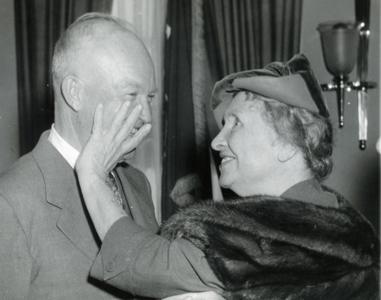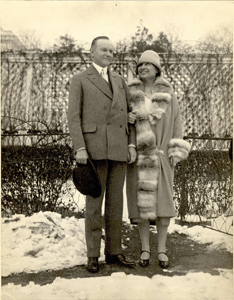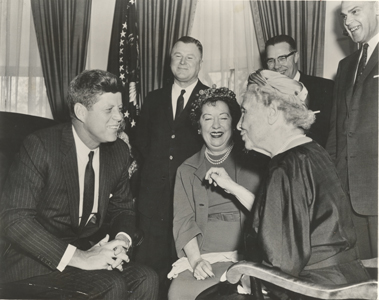

"Only people count. Only people who think and feel and work together make civilization. Only governments that keep every door of opportunity wide open are civilized governments...Civilization means a fair chance to live. It means an equitable share of the resources of the earth for every one. It means health and freedom and education for all men."
Helen Keller, draft of speech, June 1918
When Helen Keller was 6 years old she met President Grover Cleveland. Cleveland was the first of many U.S. presidents that she met during her lifetime. The Helen Keller Archives at the American Foundation for the Blind contains correspondence with 9 sitting U.S. Presidents: Theodore Roosevelt, Woodrow Wilson, Calvin Coolidge, Herbert Hoover, Franklin D. Roosevelt, Harry Truman, Dwight D. Eisenhower, John F. Kennedy, and Lyndon B. Johnson.
Keller enjoyed both personal and professional friendships with this country’s leaders. It was perhaps as the nation’s champion for those who were blind or visually impaired that she came in greatest contact with its Commanders in Chief. Keller doggedly solicited federal and state governments to help improve the lives of those with vision loss. At the federal level, among her many achievements, she successfully lobbied the government in the 1930s to print and distribute books in braille for use by the adult blind across the United States, and from 1942-1944, she supported Senator Robert Wagner’s efforts to secure funding for the rehabilitation, special vocational training, placement, and supervision of blind persons, including those blinded in World War II.
Keller famously had the ear of both Franklin Delano Roosevelt and his wife Eleanor. During the Great Depression, Keller petitioned President Roosevelt to make the creation of audio recordings "Talking Books," a Works Progress Administration project. The Talking Book revolutionized access to literature and information for those who could not see. Keller successfully advocated for an extensive national program for these recordings, even though as she was both deaf and blind she could not utilize them. This national lending library of recorded and braille books continues today (as the National Library Service for the Blind and Physically Handicapped) with nearly a million users.
Keller powerfully believed in the efficacy of a government that was actively involved in assuring the welfare of its citizens.
Images, left to right: Helen Keller with President Dwight Eisenhower. The fingers of Keller's left hand are placed on the President's face to "see" what he looks like, 1953; Keller stands in the snow next to President Calvin Coolidge, circa 1926; Keller is seated opposite President Kennedy at the White House, 1961.
